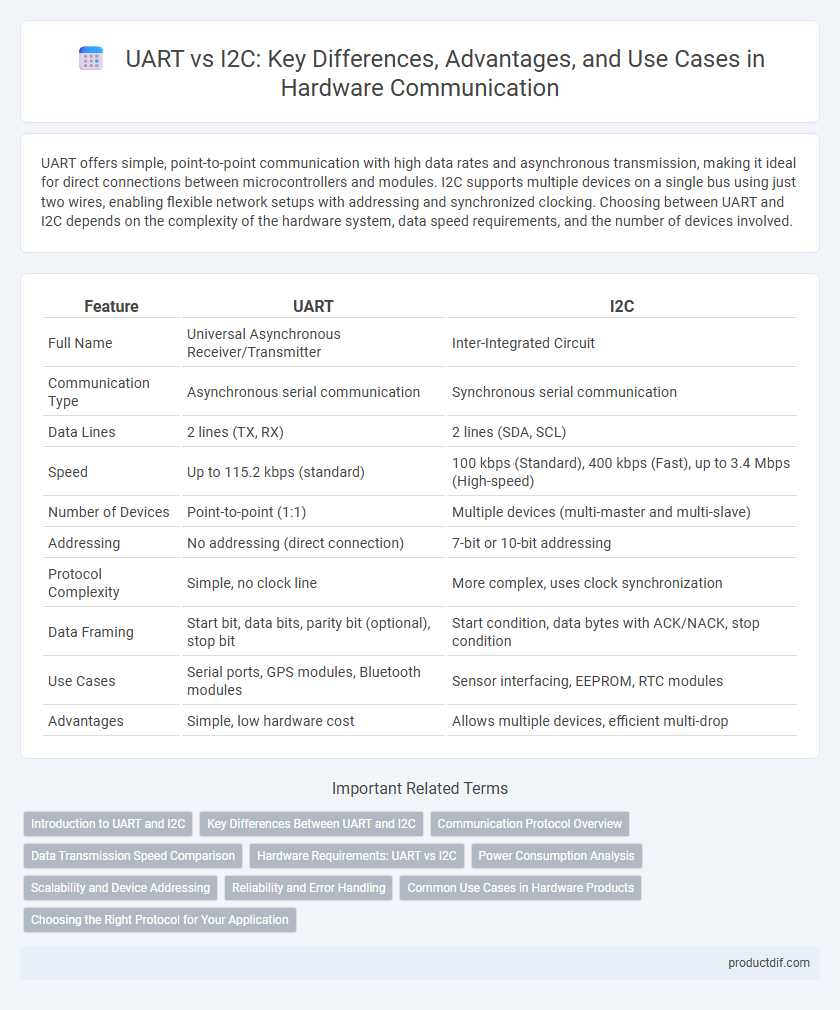UART offers simple, point-to-point communication with high data rates and asynchronous transmission, making it ideal for direct connections between microcontrollers and modules. I2C supports multiple devices on a single bus using just two wires, enabling flexible network setups with addressing and synchronized clocking. Choosing between UART and I2C depends on the complexity of the hardware system, data speed requirements, and the number of devices involved.
Table of Comparison
| Feature | UART | I2C |
|---|---|---|
| Full Name | Universal Asynchronous Receiver/Transmitter | Inter-Integrated Circuit |
| Communication Type | Asynchronous serial communication | Synchronous serial communication |
| Data Lines | 2 lines (TX, RX) | 2 lines (SDA, SCL) |
| Speed | Up to 115.2 kbps (standard) | 100 kbps (Standard), 400 kbps (Fast), up to 3.4 Mbps (High-speed) |
| Number of Devices | Point-to-point (1:1) | Multiple devices (multi-master and multi-slave) |
| Addressing | No addressing (direct connection) | 7-bit or 10-bit addressing |
| Protocol Complexity | Simple, no clock line | More complex, uses clock synchronization |
| Data Framing | Start bit, data bits, parity bit (optional), stop bit | Start condition, data bytes with ACK/NACK, stop condition |
| Use Cases | Serial ports, GPS modules, Bluetooth modules | Sensor interfacing, EEPROM, RTC modules |
| Advantages | Simple, low hardware cost | Allows multiple devices, efficient multi-drop |
Introduction to UART and I2C
UART (Universal Asynchronous Receiver/Transmitter) is a serial communication protocol that enables full-duplex data exchange between devices over two wires: transmit (TX) and receive (RX). I2C (Inter-Integrated Circuit) is a multi-master, multi-slave, packet-switched, single-ended, serial communication bus commonly used for short-distance communication within embedded systems. UART operates asynchronously without a clock signal, while I2C uses a clock line (SCL) to synchronize data transfer on the data line (SDA).
Key Differences Between UART and I2C
UART uses asynchronous serial communication with two wires, RX and TX, enabling point-to-point connections, while I2C employs synchronous serial communication with two wires, SDA and SCL, supporting multi-master and multi-slave configurations. UART typically has higher data transfer rates suitable for long-distance communication, whereas I2C is optimized for short-distance communication with built-in addressing and collision detection. Power consumption in I2C is generally lower due to its synchronous clocking mechanism, making it ideal for embedded systems with multiple peripherals.
Communication Protocol Overview
UART (Universal Asynchronous Receiver/Transmitter) is a serial communication protocol that enables full-duplex data transmission using separate transmit and receive lines, typically requiring no clock signal. I2C (Inter-Integrated Circuit) is a synchronous, multi-master, multi-slave protocol utilizing two bidirectional lines: SDA (data) and SCL (clock), facilitating short-distance communication between integrated circuits. UART excels in simple point-to-point links, while I2C supports complex device networks with addressable nodes and clock synchronization.
Data Transmission Speed Comparison
UART typically supports data transmission speeds ranging from 9600 bps up to 3 Mbps, while I2C generally operates at standard mode speeds of 100 kbps, fast mode at 400 kbps, and high-speed mode reaching up to 3.4 Mbps. The asynchronous nature of UART enables simpler hardware implementation but may face limitations in higher data rates compared to I2C's synchronous clock-based protocol that allows faster and more reliable multi-device communication. For applications demanding rapid and efficient data transfer, I2C's clock synchronization often provides a distinct advantage over UART's variable baud rate constraints.
Hardware Requirements: UART vs I2C
UART requires only two wires, TX and RX, along with a common ground, enabling full-duplex communication with minimal hardware complexity. I2C uses two bidirectional lines, SDA and SCL, to facilitate multipoint communication, requiring pull-up resistors on each line to maintain signal integrity. UART hardware is simpler but less scalable, while I2C hardware demands precise timing control and bus arbitration for multiple devices.
Power Consumption Analysis
UART typically consumes more power than I2C due to its continuous signal transmission and higher data rates, which require sustained current flow in the transmitter and receiver circuits. I2C operates with lower power consumption by using open-drain lines and pull-up resistors, enabling devices to enter low-power standby modes between communication bursts effectively. The bi-directional, multi-master capability of I2C further reduces power by allowing flexible control over bus activity, making it more efficient for battery-powered and low-energy embedded systems.
Scalability and Device Addressing
UART supports point-to-point communication with limited scalability due to its lack of inherent device addressing, constraining the connection to two devices per bus. In contrast, I2C offers high scalability by allowing multiple devices on the same bus using unique 7-bit or 10-bit addressing, enabling up to 127 or 1024 devices respectively. This addressing scheme makes I2C ideal for complex hardware systems requiring communication with numerous peripherals.
Reliability and Error Handling
UART offers simple point-to-point communication with basic error detection through parity bits, making it reliable for short-distance, low-speed data transfer. I2C incorporates built-in acknowledgment and clock stretching mechanisms, enhancing error detection and handling capabilities for multi-device communication. The error handling robustness in I2C typically surpasses UART due to its ability to manage bus arbitration and device addressing conflicts efficiently.
Common Use Cases in Hardware Products
UART is commonly used in serial communication for microcontrollers, GPS modules, and Bluetooth devices, enabling straightforward point-to-point data transfer. I2C excels in sensor networks, EEPROM interfacing, and multi-slave environments due to its multi-master, multi-slave capability on a two-wire bus. Hardware products leverage UART for simple, low-speed communication and I2C for complex device ecosystems requiring synchronized data exchange.
Choosing the Right Protocol for Your Application
UART offers simplicity and point-to-point communication ideal for short-distance, low-speed serial data transfer, while I2C supports multi-master, multi-slave connectivity suited for complex sensor networks and peripheral interfacing. Selecting UART is beneficial when dealing with fewer devices and straightforward wiring, whereas I2C excels in applications requiring scalability and multiple device addressing on the same bus. Consider factors like data speed, device count, wiring complexity, and power consumption to determine the most efficient protocol for your hardware design.
UART vs I2C Infographic

 productdif.com
productdif.com